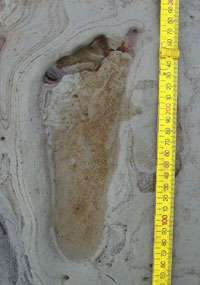Stone Age hunters used the environment to improve standard of living

(Phys.org)—Extraordinary evidence showing that Stone Age people were more than just hunters has been found at a threatened archaeological site on the Severn Estuary.
Researchers from the University of Reading found 7500 year-old worked flint 'tools', bones, charcoal and hazelnut shells while working at Goldcliff, near Newport, in September.
These finds indicate that Mesolithic people were manipulating the environment to increase their resources, thousands of years before farming began. Charcoal remains suggest these people used fire to encourage the growth of plants, such as hazelnuts, crab apples and raspberries. The researchers believe all these were eaten.
Most of the evidence in Britain for hunter-gatherer relates to the hunting of animals as bones survive on more sites, so the plant part of their diet tends to be ignored. The Severn Estuary sites however are exceptional in providing evidence for a wide range of plant resources.
Professor Martin Bell, Head of the University of Reading's Department of Archaeology, is leading the Severn Estuary project. He said: "Previously it was thought that these people were mainly hunting deer and simply responding to the spectacular environmental changes around them, such as sea level rise. Now there is increasing evidence that they were adept at manipulating their environment to increase valued plant resources.
"Combining our finds with the trees, pollen and insects from the area we can build a picture of the environmental relationships of Mesolithic hunter-gatherers. These people were highly adaptable and continued using the same site as the environment changed dramatically from old woodland to reedswamp, to saltmarsh and back to fen woodland."
Over the last two summers researchers from the University of Reading have found Stone Age footprints at Goldcliff and new archaeological finds, including footprints of animals and birds, are constantly being made in the Severn Estuary.
Professor Bell continued said: "The 7500 year old footprint trails show how the activity areas represented by flint tools and bones articulated together as parts of a living stone age landscape. The footprints include those made by children, which is extremely exciting as the role of children tends not to be visible in the archaeological record. They show youngsters as young as four were actively engaged in the productive activities of the community."
The House of Commons Select Committee on Climate Change is once again considering a Severn Tidal Barrage. This scheme would have a major impact on the rich archaeological resource of the Severn Estuary which is giving archaeologists an unparalleled glimpse into the life of a Stone Age settlement.
"From an archaeological point of view construction of a Severn Tidal Barrage would have very serious consequences alongside the more widely recognised ecological risks to fish, birds and many other organisms," continued Professor Bell. "The tidal range will be reduced, sites will be permanently submerged, sedimentation will increase in some areas and, as patterns of erosion change, some site, including those with exceptional preservation of organic artefacts, may be rapidly destroyed.
The Severn Estuary project is featured in the December issue of National Geographic.
Provided by University of Reading


















